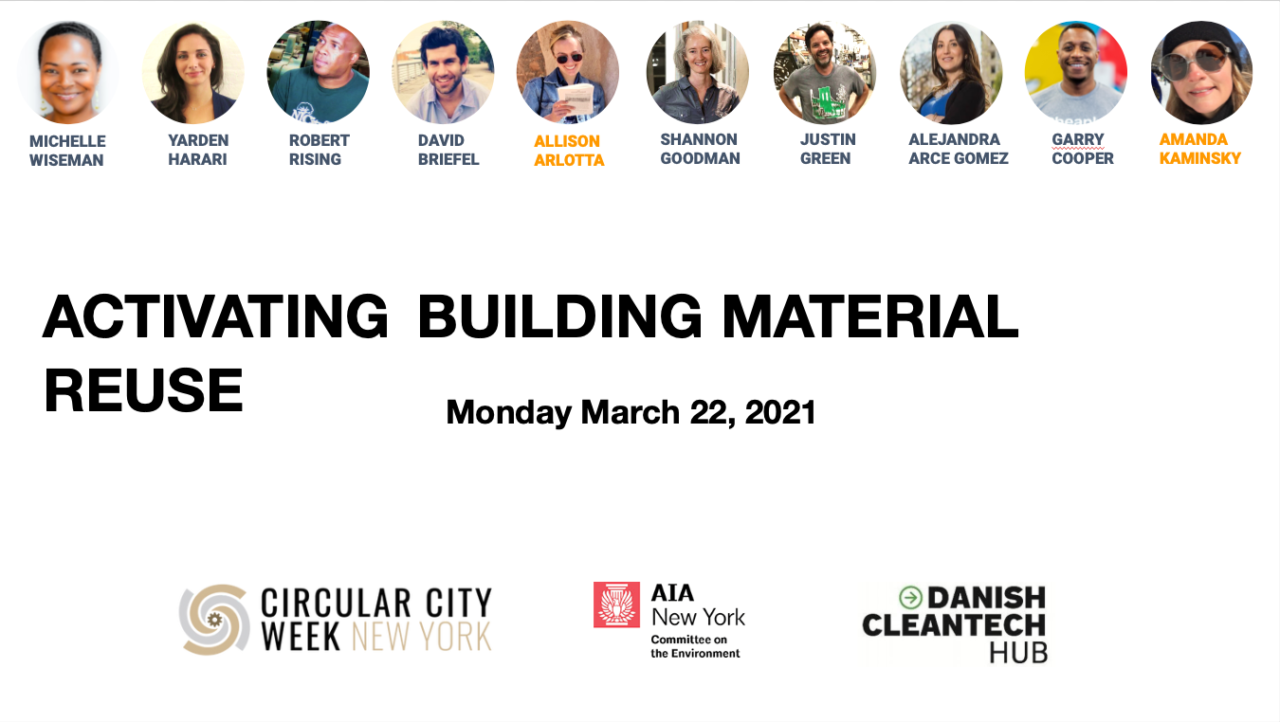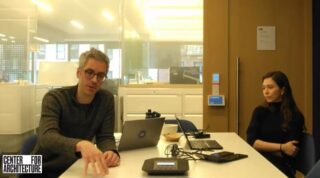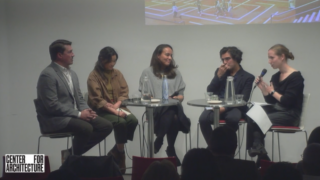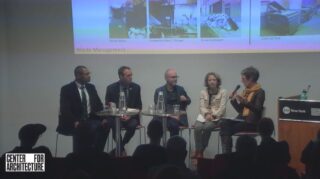Info
Related Links
Upcoming Events
-
Fri, 7/11, 12:30pm
Topics
-
June 28, 2022
New residential buildings over 150 units in New York City now need to submit a Waste Management Plan for DSNY review at the same time as they submit plans to DOB. Hear from DSNY how the process works, and what they need to see in a plan. Walk through a sample plan and learn how to reduce the heap of trash bags typically set out on sidewalks. See case studies of how architects have applied best practice strategies to effectively separate recycling and food waste, reduce the volume of waste and ensure efficient waste management for building staff.
This course takes content from the AIANY webinar that took place on May 20 and adds more content. This includes how to use the Zero Waste Design Guidelines calculator for 150% storage volume, as well as further case studies and Q&A from event attendees.
This free online course offers 1 LU/HSW CEU with successful completion of the online quiz.
-
March 29, 2021

In collaboration with Circular City Week NYC, the AIA New York’s Committee on the Environment hosted an outstanding roundtable to discuss how material reuse can be collaboratively activated by designers, municipalities, and reuse organizations to help reduce waste and carbon impact, and to create an increasingly circular built environment.
Today, the dominant model for resource consumption in construction is linear: resources are extracted, processed into usable materials, which are then assembled into buildings. The buildings are used until they reach the end of their life—or their perceived end-of-life—and then demolished, with their waste largely dumped into landfills. Then with each new construction, too often we use materials that further extract virgin resources. This has environmental implications for our climate crisis: the transportation and processing of materials produce greenhouse gas emissions, whose accumulation in the atmosphere is causing irreversible climate change. Natural resources vary in their renewability and many are at risk for overconsumption.
This linear model also has an immense human impact. Landfills have detrimental health effects for their host communities, and mechanical demolition can produce dangerous levels of lead dust and particulate matter. Here in New York City, over 2,000 children test positive for lead poisoning every year. These environmental hazards cannot be separated from systemic issues of race and class, as we know that demolition, landfills, and lead poisoning disproportionately affect poor communities and communities of color.
In the US, our linear model is generating 600 million tons of construction and demolition (C&D) waste each year—twice the amount of municipal solid waste (MSW) generated. And while we tend to focus on reuse in residential projects, non-residential demolition actually contributes the most to construction and demolition waste. Which means we are missing an opportunity within commercial and institutional projects to reclaim and reuse material.
Only an estimated 22% of this mixed C&D debris gets diverted from going to landfills or turning into aggregate. Much of this diversion comes in the form of recycling rather than reuse. Many materials downgrade in quality or integrity with each recycling, limiting the number of times they can recycled. Recycling often delays but does not prevent a material from being disposed. In a circular system, this “waste” would provide the “feed” for new buildings and products, diverting this material from landfills, prolonging the life of natural resources, and minimizing greenhouse gas emissions.
One way to make construction more circular is through the deconstruction of buildings at the end of their lives instead of demolition, which some of our speakers will be talking about today. Deconstruction is the process of dismantling a structure methodically, mostly by hand, in order to maximize the recovery of reusable material. Because it requires more manual labor, deconstruction is also a job creator. Research from Portland, where deconstruction of certain building types is required, found that deconstruction projects employed twice as many people as typical demolition. Deconstruction also produces less toxic dust than mechanical demolition and it often uncovers previously unidentified abatable material like asbestos.
Material reuse is critical for reducing greenhouse gas emissions, conserving natural resources, and decreasing landfilling, and has the potential to protect public health and create jobs. As part of Circular City Week NYC, the AIA New York’s Committee on the Environment hosted an outstanding roundtable to discuss how reuse can be collaboratively activated by designers, municipalities, and reuse organizations to help reduce waste and carbon impact, and to create an increasingly circular built environment.
Justin Green (Executive Director, BIG Reuse) and Robert Rising (NYCitySlab) talked about working with salvaged materials in New York and what draws their customers to choose reuse. Shannon Goodman (Executive Director, LifeCycle Building Center) and Michelle Wiseman (Director of Waste Diversion, City of Atlanta) shared the work they are doing to build reuse infrastructure in Atlanta with a focus on community benefit. David Briefel (Regional Sustainability Design Director, Gensler) talked about the importance of prioritizing embodied energy, not just operational energy, in architecture projects, while Yarden Harari (Associate, CallistonRTKL) discussed her firm’s material reuse stakeholder workshops. The roundtable also touched on new business approaches to reuse: Alejandra Arce Gomez (Sustainability Director, GCI Contractors/Madrone) explained her company’s innovative in-house salvage and material matching program; and Garry Cooper shared the work of his technology startup Rheaply, which helps organizations waste less by buying and selling surplus assets.
Circular City Week provided a rare opportunity to have this important conversation and to hear from such a wide range of perspectives within the world material reuse. Moderators Amanda Kaminksy (Founder, Building Product Ecosystems) and Allison Arlotta (Board Member, Build Reuse) hope to continue the discussion at future events.
-
February 12, 2021
Our Energy Modeling subcommittee collaborated with AIA Philadelphia’s 2030 Working Group on this great series which will help your firm meet AIA 2030 commitments.
Register with AIA Philadelphia > -
February 3, 2020
In-office presentations on the Zero Waste Design Guidelines are available to architects, developers and associated professionals in NYC. This year there is an additional course offering on Design Strategies and Case studies at the District Scale.
For a free consultation on how best to apply zero waste design strategies to a particular project in NYC, see Project Consultation:How to Apply Best Practice Design Strategies to Reduce Waste. Reach out to clare@centerforzerowastedesign.org to schedule.
-
COTE is keenly aware of the importance of reducing embodied carbon in buildings. At the Embodied Carbon Part 1: The Blindspot in the Building Industry event and workshop last fall, COTE member Kristina Miele launched the AIA New York local chapter of the Embodied Carbon Network, in collaboration with COTE.
Please join us for Embodied Carbon Part 2: Practical Design Decisions for Reducing Embodied Carbon on February 18 (see details here).
Past Events
-
Fri, 5/16/25, 9:00am
-
Thu, 3/20/25, 2:00pm
-
Tue, 11/12/24, 6:00pm
-
Wed, 10/16/24, 6:00pm
-
Mon, 10/7/24, 5:30pm














![Image of Panelists at Wast[ED] Working with Trash](https://www.aiany.org/wp-content/uploads/sites/2/2023/11/Screenshot-2023-11-09-at-6.34.30-PM-320x180.png)